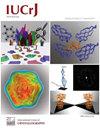CEMOVIS的原位高分辨率低温电镜重建。
IF 3.6
2区 材料科学
Q2 CHEMISTRY, MULTIDISCIPLINARY
引用次数: 0
摘要
低温电子显微镜可用于高分辨率的细胞和组织成像。为了保证电子的透明度,样品的厚度不能超过500nm。聚焦离子束(FIB)铣削已成为制备薄样品(薄片)的标准方法;然而,通过铣削过程去除的材料会丢失,可成像的区域通常限制在几平方微米,并且表层会受到离子束的损伤。我们研究了玻璃体切片的低温电子显微镜(CEMOVIS),这是一种基于用刀切割薄片的技术,作为FIB铣削的替代方法。玻璃体部分也会受到损伤,包括压缩、剪切和裂纹。然而,样品可以连续切片,与薄片相比,产生更多数量级的可成像面积,使CEMOVIS成为FIB铣削的替代方案,具有明显的优势。通过对酿酒酵母细胞玻璃体切片图像的二维模板匹配,我们在近原子分辨率下重建了60S核糖体亚基,结果表明,在切片的许多区域,这些亚基的分子结构在很大程度上是完整的,与fib研磨的薄片相当。本文章由计算机程序翻译,如有差异,请以英文原文为准。
In situ high-resolution cryo-EM reconstructions from CEMOVIS
Vitreous sectioning (CEMOVIS) is an alternative to FIB milling for generating thin samples suitable for cryo-EM imaging. We show that CEMOVIS samples preserve the high-resolution structural details of macromolecular complexes such as the 60S ribosome, despite the visible macroscopic damage visible in the samples.
Cryo-electron microscopy can be used to image cells and tissue at high resolution. To ensure electron transparency, the sample thickness must not exceed 500 nm. Focused-ion-beam (FIB) milling has become the standard method for preparing thin samples (lamellae); however, the material removed by the milling process is lost, the imageable area is usually limited to a few square micrometres and the surface layers sustain damage from the ion beam. We have examined cryo-electron microscopy of vitreous sections (CEMOVIS), a technique based on cutting thin sections with a knife, as an alternative to FIB milling. Vitreous sections also sustain damage, including compression, shearing and cracks. However, samples can be sectioned in series, producing many orders of magnitude more imageable area compared to lamellae, making CEMOVIS an alternative to FIB milling with distinct advantages. Using two-dimensional template matching on images of vitreous sections of Saccharomyces cerevisiae cells, we reconstructed the 60S ribosomal subunit at near-atomic resolution, demonstrating that, in many regions of the sections, the molecular structure of these subunits is largely intact, comparable to FIB-milled lamellae.
求助全文
通过发布文献求助,成功后即可免费获取论文全文。
去求助
来源期刊

IUCrJ
CHEMISTRY, MULTIDISCIPLINARYCRYSTALLOGRAPH-CRYSTALLOGRAPHY
CiteScore
7.50
自引率
5.10%
发文量
95
审稿时长
10 weeks
期刊介绍:
IUCrJ is a new fully open-access peer-reviewed journal from the International Union of Crystallography (IUCr).
The journal will publish high-profile articles on all aspects of the sciences and technologies supported by the IUCr via its commissions, including emerging fields where structural results underpin the science reported in the article. Our aim is to make IUCrJ the natural home for high-quality structural science results. Chemists, biologists, physicists and material scientists will be actively encouraged to report their structural studies in IUCrJ.
 求助内容:
求助内容: 应助结果提醒方式:
应助结果提醒方式:


